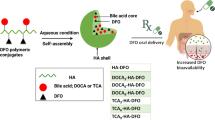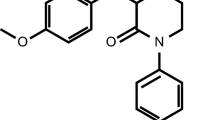Abstract
The interactions between cyclophosphamide hydrochloride (CYC) and aspirin (ASA) with human serum albumin (HSA) were investigated by measuring fluorescence anisotropy, poly-dispersity index, and time-resolved fluorescence. Also, isothermal titration calorimetry (ITC) was performed. The fluorescence spectra of the drugs exhibited an appreciable hypsochromic shift along with an enhancement in the fluorescence intensity. The gradual addition of HSA led to a marked increase in fluorescence anisotropy (r), and from this value it is argued that the drugs were located in a restricted environment of the protein. The binding constants for the ASA–HSA and CYC–HSA complexes were found to be 1.27 × 108 and 4.23 × 108 mol·L−1, respectively, as calculated from the relevant fluorescence data. The polydispersity index and size distribution of the protein–drug complex were measured at several concentrations of the drugs by the zeta potential technique, which confirmed the already obtained experimental results. From the analysis of the steady-state and time-resolved fluorescence quenching of the drugs in aqueous solutions in the presence of HSA, it was found that the quenching is static in nature. ITC experiments revealed that, in the absence of drugs, the dominant forces are electrostatic, whereas hydrophobic and weak electrostatic forces became significant in the presence of the drug. The primary binding pattern between the drugs and HSA was interpreted as a combined effect of hydrophobic association and electrostatic interactions.





Similar content being viewed by others
References
Kragh-Hansen, U., Chuang, V.T.G., Otagiri, M.: Practical aspects of the ligand binding and enzymatic properties of human serum albumin. Biol. Pharm. Bull. 25, 695–704 (2002)
Bertucci, C., Andrisano, V., Gotti, R., Cavrini, V.: Use of an immobilised human determined by using of other methods. Serum albumin HPLC column as a probe of drug–protein interactions: the reversible binding of valproate. J. Chromatogr. B 768, 147–155 (2002)
Ni, Y., Su, S., Kokot, S.: Spectrofluorimetric studies on the binding of salicylic acid to bovine serum albumin using warfarin and ibuprofen as sitemarkers with the aid of parallel factor analysis. Anal. Chim. Acta 580, 206–215 (2006)
Liu, X., Song, D., Zhang, Q., Tian, Y., Liu, Z., Zhang, H.: Characterization of drug-binding levels to serum albumin using a wavelength modulation surface plasmon resonance sensor. Sens. Actuators 117, 188–195 (2006)
Birkett, D.L.: Drug protein binding. Aust. Prescr. 15, 56–57 (1992)
Sulkowska, A., Maciazek-Jurczyk, M., Bojko, B., Rownicka, J., Zubik-Skupien, I., Temba, E., Pentak, D., Sulkowski, W.: Competitive binding of phenylbutazone and colchicine to serum albumin in multidrug therapy: a spectroscopic study. J. Mol. Struct. 881, 97–106 (2008)
Maciazek-Jurczyk, M., Sutkowska, A., Bojko, B., Rownicka, J., Sutkowski, W.W.: Fluorescence analysis of competition of phenylbutazone and methotrexate in binding to serum albumin in combination treatment in rheumatology. J. Mol. Struct. 924, 378–384 (2009)
Peters Jr, T.: All about albumin: biochemistry, genetics, and medical applications. Academic Press, San Diego (1995)
Wang, Y.-Q., Tang, B.-P., Zhang, H.-M., Zhou, Q.-H., Zhang, G.-C.: Studies on the interaction between imidacloprid and human serum albumin: spectroscopic approach. J. Photochem. Photobiol. B Biol. 94, 183–190 (2009)
Subramanyam, R., Gollapudi, A., Bonigala, P., Chinnaboina, M., Amooru, D.G.: Betulinic acid binding to human serum albumin: a study of protein conformation and binding affinity. J. Photochem. Photobiol. B Biol. 94, 8–12 (2009)
Banerjee, P., Ghosh, S., Sarkar, A., Chandra Bhattacharya, S.: Fluorescence resonance energy transfer: a promising tool for investigation of the interaction between 1-anthracene sulphonate and serum albumins. J. Lumin. 131, 316–321 (2011)
Chen, C., Ge, F., Liu, D., Han, B., Xiong, X., Zhao, S.: Study on the interaction between theasinesin and human serum albumin by fluorescence spectroscopy. J. Lumin. 130, 168–173 (2010)
Carter, D., Ho, J.X.: Structure of serum albumin. Adv. Protein Chem. 45, 153–159 (1994)
Li, Y.S., Ge, Y.S., Zhang, Y., Zhang, A.Q., Sun, S.F., Jiang, F.L., Liu, Y.: Interaction of coomassie brilliant blue G250 with human serum albumin: probing of the binding mechanism and binding site by spectroscopic and molecular modeling methods. J. Mol. Struct. 968, 24–31 (2010)
Zhang, G., Que, Q., Pan, J., Guo, J.: Study of the interaction between icariin and human serum albumin by fluorescence spectroscopy. J. Mol. Struct. 881, 132–138 (2008)
Matei, L., Hillebrand, M.: Interaction of kaempferol with human serum albumin: a fluorescence and circular dichroism study. J. Pharm. Biomed. Anal. 51, 768–773 (2010)
Cui, F., Zhang, Q., Yao, X., Luo, H., Yang, Y., Qin, L., Qu, G., Lu, Y.: The investigation of the interaction between 5-iodouracil and human serum albumin by spectroscopic and modeling methods and determination of protein by synchronous fluorescence technique. J. Pest. Biochem. Physiol. 90, 126–134 (2008)
Yuan, J.L., Lv, Z., Liu, Z.G., Hu, Z., Zou, G.L.: Study on interaction between apigenin and human serum albumin by spectroscopy and molecular modeling. J. Photochem. Photobiol. A Chem. 191, 104–113 (2007)
Petitpas, J., Bhattacharga, A.A., Twine, S., East, M., Curry, S.: Crystal structure analysis of warfarin binding to human serum albumin: anatomy of drug site I. J. Biol. Chem. 276, 22804–22809 (2001)
Hamed-Akbari Tousi, S., Saberi, M.R., Chamani, J.: Comparing the Interaction of cyclophosphamide monohydrate to human serum albumin as opposed to holo-transferrin by spectroscopic and molecular modeling methods: evidence for allocating the binding site. Protein Pept. Lett. 17, 1525–1535 (2010)
Bojko, B., Sulkowska, A., Maciazek, M., Roownicka, J., Njau, F., Sulkowski, W.W.: Changes of serum albumin affinity for aspirin induced by fatty acid. J. Biol. Macromol. 42, 314–323 (2008)
Cianferoni, A., Schroeder, J.T., Kim, J., Schmidt, J.W., Lichtenstein, M.L., Georas, S.N., Casolaro, V.: Selective inhibition of interleukin-4 gene expression in human T cells by aspirin. J. Blood 97, 1742–1749 (2001)
Ibrahim, H., Boyer, A., Bouajila, J., Couderc, F., Nepveu, F.: Determination of non-steroidal anti-inflammatory drugs in pharmaceuticals and human serum by dual-mode gradient HPLC and fluorescence detection. J. Chromatogr. B 857, 59–66 (2007)
Wang, T., Xiang, B.R., Li, Y., Chen, C.Y., Zhou, X.H., Wang, Z.M., Dong, Y., Wang, Y., Fang, H.S.: Studies on the binding of a carditionic agent to human serum albumin by two-dimensional correlation fluorescence spectroscopy and molecular modeling. J. Mol. Struct. 921, 188–198 (2009)
Maiti, T.K., Ghosh, K.S., Samanta, A., Dasgupta, S.: The interaction of silibinin with human serum albumin: a spectroscopic investigation. J. Photochem. Photobiol. A Chem. 194, 297–307 (2008)
Bogdan, M., Pirnau, A., Floare, C., Bugeac, C.: Binding interaction of indomethacin with human serum albumin. J. Pharm. Biomed. Anal. 47, 981–984 (2008)
Wang, Z., Kumar, N.R., Srivasva, D.K.: A novel spectroscopic titration for determining the dissociation constant and stoichiometry of protein–ligand complex. Anal. Biochem. 206, 376–381 (1992)
Xiang, G., Tong, C., Lin, H.: Nitroaniline isomers interaction with bovine serum albumin and toxicological implications. J. Fluoresc. 17, 512–521 (2007)
Li, Y., He, W., Dong, Y., Sheng, F., Hu, Z.: Human serum albumin interaction with formononetin studied using fluorescence anisotropy, FT-IR spectroscopy, and molecular modeling methods. J. Bioorg. Med. Chem. 14, 1431–1436 (2006)
Takeda, S., Terazono, B., Mishima, F., Nakagami, H., Nishijima, S., Kaneda, Y.: Novel drug delivery system by surface modified magnetic nanoparticles. J. Nanosci. Nanotechnol. 6(9–10), 3269–3276 (2006)
Yuan, X., Li, L., Rathinavelu, A., Hao, J., Narasimhan, M., He, M., Heitlage, V., Tam, L., Viqar, S., Salehi, M.: SiRNA drug delivery by biodegradable polymeric nanoparticles. J. Nanosci. Nanotechnol. 6(9–10), 2821–2828 (2006)
Cheng, J., Teply, B.A., Sherifi, I., Sung, J., Luther, G., Gu, F.X., Levi-Nissenbaum, E., Radovich, A.F., Langer, R., Farokhzad, O.C.: Formulation of functionalized PLGA–PEG nanoparticles for in vivo targeted drug delivery. Biomaterials 28(5), 869–876 (2007)
Thanos, C.G.: Improving relative bioavailability of dicumarol by reducing particle size and adding the adhesive poly (fumaric-co-sebacic) anhydride. Pharm. Res. 20, 1093–1100 (2003)
Vila, A., Sanchez, A., Evora, C., Soriano, I., Callion, M.C., Alonso, M.L.: PLA–PEG particles as nasal protein carriers: the influence of the particle size. Int. J. Pharm. 292, 43–52 (2005)
Wu, H., Ramachandran, C., Weiner, N.D., Roessler, B.J.: Topical transport of hydrophilic compounds using water-in-oil nanoemulsions. Int. J. Pharm. 220, 63–75 (2001)
Sarker, D.K.: Engineering of nanoemulsions for drug delivery. Curr. Drug Deliv. 2, 297–310 (2005)
Subramanian, B., Kuo, F., Ada, E., Kotyla, T., Wilson, T., Yoganathan, S., Nicolosi, R.: Enhancement of anti-inflammatory property of aspirin in mice by a nano-emulsion preparation. Int. Immunopharmacol. 8, 1533–1539 (2008)
Belatik, A., Hotchandani, S., Bariyanga, J., Tajmir-Riahi, H.A.: Binding sites of retinol and retinoic acid with serum albumin. Eur. J. Med. Chem. 48, 114–123 (2012)
Bright, F.V., Munson, C.A.: Time-resolved fluorescence spectroscopy for illuminating complex systems. Anal. Chim. Acta 500, 71–104 (2003)
Chakrabarty, A., Mallick, A., Haldar, B., Das, P., Chattopadhyay, N.: Binding interaction of a biological photosensitizer with serum albumins: a biophysical study. Biomacromolecule 8, 920–927 (2007)
Shannigrahi, M., Bagchi, S.: Steady-state fluorescence and photophysical properties of a ketocyanine dye in binary surfactant and polymer–surfactant mixture. J. Photochem. Photobiol. A Chem. 168, 133–141 (2004)
Abou-Zied, O.K., Al-Shihi, O.I.K.: Characterization of subdomain IIA binding site of human serum albumin in its native, unfolded, and refolded states using small molecular probes. J. Am. Chem. Soc. 130, 10793–10801 (2008)
Pastukhov, A.V., Levchenko, L.A., Sadkov, A.P.: Spectroscopic study on binding of rutin to human serum albumin. J. Mol. Struct. 842, 60–66 (2007)
Bourassa, P., Kanakis, C.D., Torantillis, P., Pollissiou, M.G., Tajmir-Riahi, H.A.: Resveratrol, genistein and curcumin bind bovine serum albumin. J. Phys. Chem. B 114, 3348–3354 (2010)
Haq, I., Jenkins, T.C., Chowdhry, B.Z., Ren, J.S., Chaires, J.B.: In: Johnson, M.L., Ackers, G.K. (eds.) Methods in enzymology, vol. 323, pp. 373–405. Academic Press, San Diego (2000)
Ward, W.H., Holdgate, G.A.: Isothermal titration calorimetry in drug discovery. Prog. Med. Chem. 38, 309–376 (2001)
O’Brien, R., Haq, I.: In: Ladbury, J.E., Doyle, M.L. (eds.) Biocalorimetry 2: applications of calorimetry in the biological sciences, pp. 3–34. John Wiley, Chichester (2004)
Jelesarov, I., Bosshard, H.R.: Isothermal titration calorimetry and differential scanning calorimetry as complementary tools to investigate the energetics of biomolecular recognition. J. Mol. Recognit. 12, 3–18 (1999)
Velázquez-Campoy, A., Freire, E.: ITC in the post-genomic era…? Priceless. Biophys. Chem. 115, 115–124 (2005)
Dimitrova, M., Matsumura, H., Neitchev, V.: Kinetics of protein-induced flocculation of phosphatidylcholine liposomes. Langmuir 13, 6516–6523 (1997)
Haberland, M.E., Reynolds, J.A.: Interaction of l-alpha-palmitoyl lysophosphatidylcholine with the AI polypeptide of high density lipoprotein. J. Biol. Chem. 250, 6636–6639 (1975)
Dimitrova, M., Matsumura, H.: Protein-induced leakage and membrane destabilization of phosphatidylcholine and phosphatidylserine liposomes. Colloids Surf. B 8, 287–294 (1997)
Acknowledgments
The financial support of the Research Council of the Mashhad Branch, Islamic Azad University is gratefully acknowledged. The authors thank Dr. Ljungberg for the English editing.
Author information
Authors and Affiliations
Corresponding author
Rights and permissions
About this article
Cite this article
Omidvar, Z., Asoodeh, A. & Chamani, J. Studies on the Antagonistic Behavior Between Cyclophosphamide Hydrochloride and Aspirin with Human Serum Albumin: Time-Resolved Fluorescence Spectroscopy and Isothermal Titration Calorimetry. J Solution Chem 42, 1005–1017 (2013). https://doi.org/10.1007/s10953-013-0009-7
Received:
Accepted:
Published:
Issue Date:
DOI: https://doi.org/10.1007/s10953-013-0009-7




